We explore seven aquascaping styles for aquariums: Dutch, characterized by diverse plants and terraces; Taiwanese with high terraces and figurines; Iwagumi, focusing on minimalism and stone arrangements; Biotope, replicating natural environments; Jungle, emulating dense foliage; Nature Aquarium, recreating terrestrial landscapes; and Walstad, aiming for a natural, low-maintenance setup. Each style has unique characteristics and approaches to creating underwater beauty.
When you’re creating an aquarium, the possibilities are limitless. Everything from bare-bottom tanks to densely planted Dutch tanks are perfectly valid styles.
However, you’ll probably create a much more appealing result if you’re following a particular aquascaping style. Here are the most common styles you’ll see in aquariums, and some examples of each:
Table of Contents
7 Aquascaping Styles For Aquariums
1. Dutch Style
This style is characterized by many different types of plants with multiple leaf types. It’s commonly seen with raised ‘layers’, or terraces, known as Dutch ‘streets’.
The floor is covered by either a carpet, or plants, with taller plants lining the back of the tank. Most noticeably, it usually has no hardscape—you won’t see much, if any, stone or driftwood in Dutch tanks.
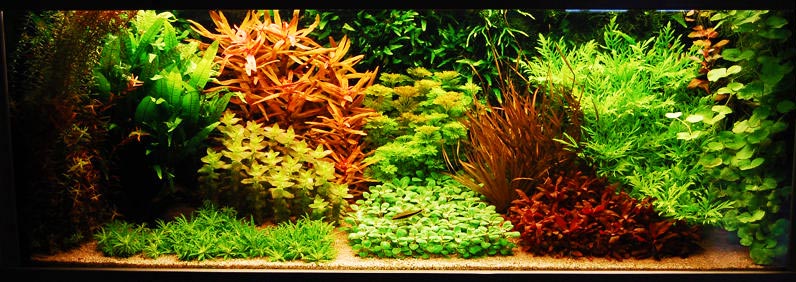
2. Taiwanese Style
This isn’t very common anymore, and has in some areas fallen ‘out-of-style’ compared to the Iwagumi or Nature Aquarium tank.
Nonetheless, it’s usually seen with high terraces of varying depth, and its strangest feature is small objects or figurines placed in the tank to create a sense of ‘life’.

3. Iwagumi Style
This is one of the most popular aquascaping styles today. It was first made popular by the Father of Modern Aquascaping, Takashi Amano, and is characterized by a series of stones arranged according to the Golden Ratio, or Rule of Thirds.
There should always be an odd number of stones to prevent the layout from ‘balancing’, since the human eye always tries to see a ‘split’ in balanced layouts.
There are at least three stones: a larger ‘Father’ stone, and at least two secondary stones. There can be more, so long as the total number remains odd.
These tanks may imitate a natural landscape, with a common theme of simplicity and open space. There are limited colors in plants & stone, and the number of varying flora and fauna is kept to a minimum to create minimalism.
Scale is very important in this style. Powder-type substrate is used to create a sense of larger scale, and the father stone should be the largest object in the aquarium. Nano fish like the Neon Tetra are also used to maintain the scale.
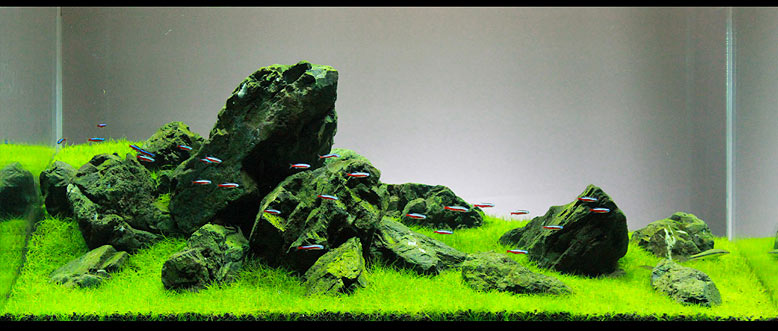
4. Biotope Style
This style seeks to perfectly emulate a natural environment, including water conditions, flora and fauna species, and even the hardscape of stone and/or driftwood. These can be quite beautiful, and are useful for some biologists to study environments that would otherwise be a challenge to study.
Oddly enough, these tanks are usually somewhat easier to setup and maintain, since there isn’t any research needed to determine whether the flora and fauna you’re using are compatible—they exist side-by-side in the wild.
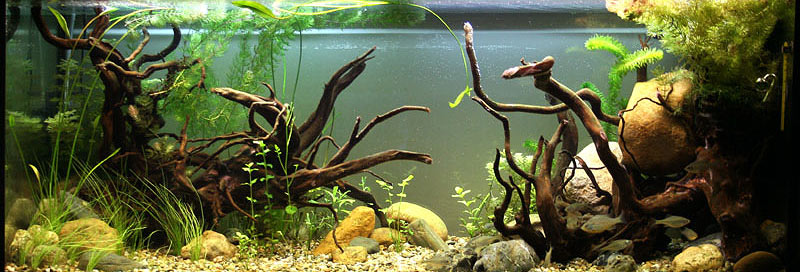
5. Jungle Style
This style is somewhat self-explanatory. The goal is to emulate a jungle, whether that’s the Amazon, or some other location. They’re quite popular in larger tanks, where the full scale of the style can be effectively portrayed.
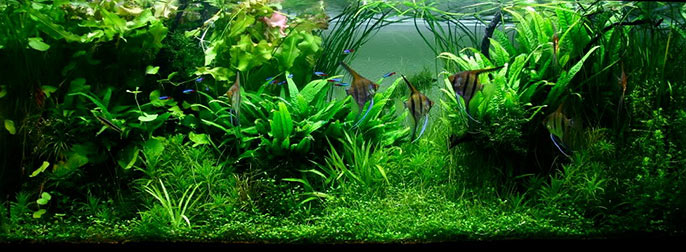
6. The Nature Aquarium
This style is the one you’ve probably seen all over the Internet, in various forums, and winning tons of awards.
And for good reason—they’re breathtaking tanks. These tanks seek to recreate various terrestrial landscapes—hills, mountains, valleys, and so on.
These are further categorized into various substyles, like the ‘island’ type, which features a stone ‘mountain’, or mound in the middle, or the triangular type, where the substrate and genearl flow the tank slopes down from one corner of the tank.
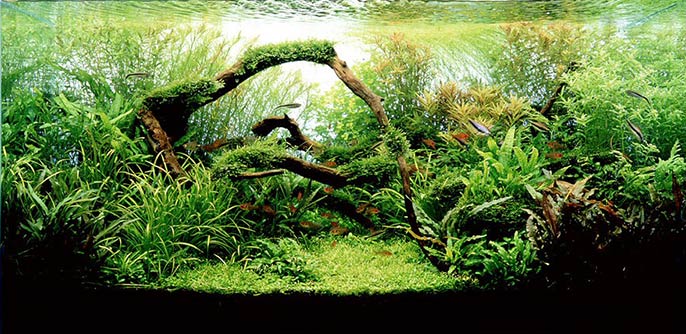
7. The Walstad Method
You’re not likely to find this style winning any Aquascaping awards, though it is a very visually appealing layout.
That’s because the goal isn’t necessarily winning beauty awards, but recreating a completely natural situation.
Where this differs from nature aquariums and biotopes is its completely random placement of hardscape and plants. This is to simulate the way things are naturally in nature, instead of placing for optimal beauty.
These tanks are most often deliberately low-maintenance, and are by design low budget tanks. They usually use potting soil and also require very few water changes, because of the plant density.

Finding Your Own Style
Of course, there are more aquascaping styles, and even more variances between each of these. it’s up to you to decide what type of tank you enjoy.
If you enjoy it, you’ll maintain it better and get more quality out of it, so choose what you’d like, and get started on your tank!

9 thoughts on “7 Aquascaping Styles for Aquariums”
Hey!
Nice site, really enjoyed it! 🙂
Excellent information different styles and ideas. Look forward to e-mails
Would really love to see more. I’m certain there are people creating hybrids that form to their own unique principles and thus apart from these basics
Have to agree with you there, Patrick. I’m sure there are those who created a hybrid. Would love to see such setup too.
Love this. Someone gifted me a small tank thinking my kids would love it. I’m learning a lot most of it the hard way but i really enjoy this.
You might want to also read this article for a small tank.
I like styles that are put together as a 3 dimension drawing of a building. For they create depth.
I dealt with Iwagumi tanks and one of my favorite styles. my first aquascape was jungle style tank with easy plants. I studied aquascaping as a hobby with my jungle tank for 6 months, before moving on to high tech tanks, like Iwagumi. My next project is a nature style with a tree stump and a lot of driftwood .
That’s really cool, Antonio. Would love to see your tank. Can you share it with us?